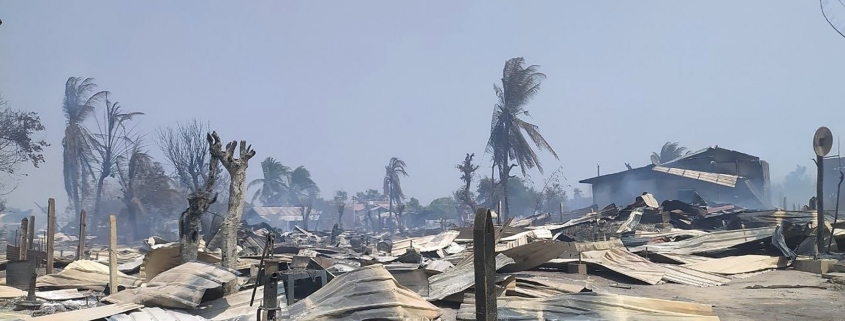Junta soldiers burn hundreds of homes and murder civilians during rampages in upper Myanmar
One of those killed was found with severe injuries on his body, suggesting he had been tortured, a local resident said
Junta soldiers killed civilians, burned hundreds of homes, and destroyed food stocks during attacks on villages in Sagaing Region last week, locals said.
Troops entered Kan Lay Kone village in Taze Township on February 21 and abducted 43-year-old Soe Moe, who they then took to another village five miles away called Thapyay Inn, according to the locals.
He was found dead on Thursday with his hands tied behind his back near a stream in Thapyay Inn. “We think he was tortured for three whole days,” said one local man. “There were a great number of injuries on the body.”
It was unclear why he was targeted, the man added. “He was on his way to check on his relatives when he ran into the junta column,” he said.
Elsewhere in Taze, Nay Win Htun, 40, was shot dead in his village of southern Chaung Sone on Friday. Locals said the soldiers threw the man’s body into his house, which they then set fire to.
Another junta column entered Taze from Kanbalu Township and raided the villages of Kan Phyu, Wat Toe and Thar Khaung Gyi on February 24, according to Taze locals.
“They’ve been terrorising those villages for three days,” said one resident. “They also torched houses that were not destroyed by artillery shells. And they killed and ate the cows in the village. They’re just doing whatever they want.”
 The body of Soe Moe who was abducted by junta soldiers in Kan Lay Kone village was found at a roadside on February 24 (Supplied)
The body of Soe Moe who was abducted by junta soldiers in Kan Lay Kone village was found at a roadside on February 24 (Supplied)
In Shwebo Township on Friday, 50 soldiers and Pyu Saw Htee militiamen burned around 400 homes in the village of Hna Ma Sar Yit. Locals later found the bodies of three residents and said three others, who were all elderly, had gone missing.
“They started firing shots at around 6am,” said one local man, adding that the attackers used both heavy and light weapons.
Yin San Aye, 33, and U Thein, 55, were later found dead with bullet wounds, while 77-year-old Khin Than died in a fire in her home, he added.
Tons of rice were also destroyed in the fires. This is the fourth time the village of some 600 houses had been attacked by the junta’s forces.
“I don’t even have the words to describe what we’re feeling right now. I would understand if we were armed and posed a threat to them. We weren’t armed in any way. The villagers were fleeing but they just kept on firing. It’s just too cruel,” the local man said.
The Pyu Saw Htee members who joined the soldiers came from Thee Lone, Pan Yan and Myin See villages, he added.
A local woman told Myanmar Now her house was burned after she fled the village with her eldery parents.
“Once all of us had fled, they started torching the houses in the southern part of the village until they reached the middle. And then my house was torched. We could also hear them yelling that they would kill anyone they saw,” she said.
Residents say many in the village have taken part in anti-coup protests.
Local news reports said thousands have been displaced by military raids on the Shwebo villages of Ywar Soe, Pauk Chaing and Seikkhun.
Soldiers burned another 40 houses with shelling in Shwebo’s Ngarpi Oe village on Thursday and killed a 25-year-old man, villagers and a local resistance force leader there said.
The attack came as retaliation after a Pyu Saw Htee leader named Myint Than was killed along with another man named La Yaung. Junta forces in the nearby village of Gway Pin Kone opened at Ngarpi Oe using artillery.
“We didn’t have enough time to do anything at all,” said the resistance force leader. “The battle was totally unexpected. They started to fire artillery shells right after the Pyu Saw Htee leader got killed.”
“We don’t have enough equipment or weapons to fight back. They continuously used heavy artillery shells. It was really overkill, considering the civilians were unarmed,” he added.
The 25-year-old man was shot dead while fleeing the attack on his motorcycle at around 9pm, he added. The fires raged until Friday morning.
“They wouldn’t have needed to use this much force even if it had been an actual battle. There were only 20 seconds between each heavy artillery shell. We couldn’t do anything but retreat,” the resistance fighter added.
The village sits along the Shwebo-Kyaukmyaung road near the entrance to the UNESCO world heritage site of Hanlin, which contains archeological ruins from the Pyu era.
“The place where the shells fell is only 15,000 feet away from the Han Lin city gate. The shell essentially fell in preserved territory,” said a 60-year-old villager named Lin.
Another man, 40, said a two-storey house, a barn and 410 litres of rice grain were also destroyed by the shells, while six cows were killed.
Over 5,000 people have fled Ngarpi Oe and the nearby villages of Gyoegyar, Kan Gyi Taw, Ywar Thit Kone and Thea Kyun because of the attacks, according to locals.




